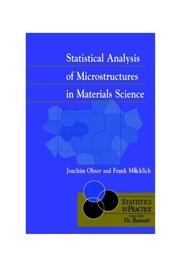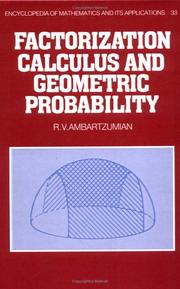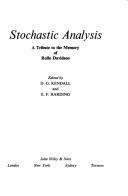| Listing 1 - 10 of 10 |
Sort by
|

ISBN: 0471974862 Year: 2000 Publisher: Chichester ; New York, NY : John Wiley,
Abstract | Keywords | Export | Availability | Bookmark
 Loading...
Loading...Choose an application
- Reference Manager
- EndNote
- RefWorks (Direct export to RefWorks)

ISBN: 0521345359 9780521345354 Year: 1990 Volume: 33 Publisher: Cambridge Cambridge University press
Abstract | Keywords | Export | Availability | Bookmark
 Loading...
Loading...Choose an application
- Reference Manager
- EndNote
- RefWorks (Direct export to RefWorks)
The classical subjects of geometric probability and integral geometry, and the more modern one of stochastic geometry, are developed here in a novel way to provide a framework in which they can be studied. The author focuses on factorization properties of measures and probabilities implied by the assumption of their invariance with respect to a group, in order to investigate nontrivial factors. The study of these properties is the central theme of the book. Basic facts about integral geometry and random point process theory are developed in a simple geometric way, so that the whole approach is suitable for a nonspecialist audience. Even in the later chapters, where the factorization principles are applied to geometrical processes, the only prerequisites are standard courses on probability and analysis. The main ideas presented have application to such areas as stereology and geometrical statistics and this book will be a useful reference book for university students studying probability theory and stochastic geometry, and research mathematicians interested in this area.
Stochastic geometry --- Factorization (Mathematics) --- Geometric probabilities --- 519.21 --- Geometry --- Probabilities --- Mathematics --- Probability theory. Stochastic processes --- Geometric probabilities. --- Stochastic geometry. --- Factorization (Mathematics). --- 519.21 Probability theory. Stochastic processes
Periodical
Abstract | Keywords | Export | Availability | Bookmark
 Loading...
Loading...Choose an application
- Reference Manager
- EndNote
- RefWorks (Direct export to RefWorks)
probability theory --- mathematical statistics --- stochastic geometry --- fractal analysis --- stochastic analysis --- financial mathematics
Book
ISBN: 1000022561 3866446691 Year: 2011 Publisher: KIT Scientific Publishing
Abstract | Keywords | Export | Availability | Bookmark
 Loading...
Loading...Choose an application
- Reference Manager
- EndNote
- RefWorks (Direct export to RefWorks)
This work is about random measures stationary with respect to a possibly non-transitive group action. It contains chapters on Palm Theory, the Mass-Transport Principle and Ergodic Theory for such random measures. The thesis ends with discussions of several new models in Stochastic Geometry (Cox Delauney mosaics, isometry stationary random partitions on Riemannian manifolds). These make crucial use of the previously developed techniques and objects.
mass-transport principle --- Random measure --- ergodic theory --- Stochastic Geometry --- Palm theory
Book
ISBN: 1000045101 3731503298 Year: 2015 Publisher: KIT Scientific Publishing
Abstract | Keywords | Export | Availability | Bookmark
 Loading...
Loading...Choose an application
- Reference Manager
- EndNote
- RefWorks (Direct export to RefWorks)
This book deals with the Boolean model, a basic model of stochastic geometry for the description of porous structures like the pore space in sand stone. The main result is a formula which gives in two and three dimensions a series representation of the most important model parameter, the intensity, using densities of so-called harmonic intrinsic volumes, which are new observable geometric quantities.
Stochastic geometry --- Boolean model --- Intensitätsschätzung --- method of densities --- anisotropy --- Anisotropie --- intensity estimation --- Boolesches Modell --- Stochastische Geometrie

ISBN: 0471468908 9780471468905 Year: 1973 Publisher: London Wiley
Abstract | Keywords | Export | Availability | Bookmark
 Loading...
Loading...Choose an application
- Reference Manager
- EndNote
- RefWorks (Direct export to RefWorks)
Probability theory --- Stochastic analysis --- Analyse stochastique --- Davidson, Rollo, --- Davidson, Rollo --- 519.216 --- #WWIS:STAT --- Analysis, Stochastic --- Mathematical analysis --- Stochastic processes --- Stochastic processes in general. Prediction theory. Stopping times. Martingales --- Festschrift - Libri Amicorum --- Stochastic analysis. --- 519.216 Stochastic processes in general. Prediction theory. Stopping times. Martingales --- Stochastic geometry --- Géométrie stochastique. --- Processus stochastiques --- Probabilités. --- Probabilities --- Géométrie stochastique. --- Probabilités
Book
ISBN: 3030135470 3030135462 Year: 2019 Publisher: Cham : Springer International Publishing : Imprint: Springer,
Abstract | Keywords | Export | Availability | Bookmark
 Loading...
Loading...Choose an application
- Reference Manager
- EndNote
- RefWorks (Direct export to RefWorks)
This volume offers a unique and accessible overview of the most active fields in Stochastic Geometry, up to the frontiers of recent research. Since 2014, the yearly meeting of the French research structure GDR GeoSto has been preceded by two introductory courses. This book contains five of these introductory lectures. The first chapter is a historically motivated introduction to Stochastic Geometry which relates four classical problems (the Buffon needle problem, the Bertrand paradox, the Sylvester four-point problem and the bicycle wheel problem) to current topics. The remaining chapters give an application motivated introduction to contemporary Stochastic Geometry, each one devoted to a particular branch of the subject: understanding spatial point patterns through intensity and conditional intensities; stochastic methods for image analysis; random fields and scale invariance; and the theory of Gibbs point processes. Exposing readers to a rich theory, this book will encourage further exploration of the subject and its wide applications. .
Distribution (Probability theory. --- Mathematical statistics. --- Computer vision. --- Probability Theory and Stochastic Processes. --- Statistical Theory and Methods. --- Computer Imaging, Vision, Pattern Recognition and Graphics. --- Mathematical Applications in the Physical Sciences. --- Machine vision --- Vision, Computer --- Artificial intelligence --- Image processing --- Pattern recognition systems --- Mathematics --- Statistical inference --- Statistics, Mathematical --- Statistics --- Probabilities --- Sampling (Statistics) --- Distribution functions --- Frequency distribution --- Characteristic functions --- Statistical methods --- Stochastic geometry. --- Geometry --- Probabilities. --- Statistics . --- Optical data processing. --- Mathematical physics. --- Physical mathematics --- Physics --- Optical computing --- Visual data processing --- Bionics --- Electronic data processing --- Integrated optics --- Photonics --- Computers --- Statistical analysis --- Statistical data --- Statistical science --- Econometrics --- Probability --- Combinations --- Chance --- Least squares --- Mathematical statistics --- Risk --- Optical equipment
Book
ISBN: 3039281496 3039281488 Year: 2020 Publisher: MDPI - Multidisciplinary Digital Publishing Institute
Abstract | Keywords | Export | Availability | Bookmark
 Loading...
Loading...Choose an application
- Reference Manager
- EndNote
- RefWorks (Direct export to RefWorks)
The Internet of Things (IoT) has attracted much attention from society, industry and academia as a promising technology that can enhance day to day activities, and the creation of new business models, products and services, and serve as a broad source of research topics and ideas. A future digital society is envisioned, composed of numerous wireless connected sensors and devices. Driven by huge demand, the massive IoT (mIoT) or massive machine type communication (mMTC) has been identified as one of the three main communication scenarios for 5G. In addition to connectivity, computing and storage and data management are also long-standing issues for low-cost devices and sensors. The book is a collection of outstanding technical research and industrial papers covering new research results, with a wide range of features within the 5G-and-beyond framework. It provides a range of discussions of the major research challenges and achievements within this topic.
fog computing --- heterogeneous networks --- distributed mechanism --- energy efficiency --- scheduling --- CSMA --- throughput --- grant-free --- D2D communication --- MAC --- Industrial Internet of Things --- estimation --- 5G --- survey --- liquid detection --- power control --- sensor --- SINR --- radio propagation --- MU association --- Raspberry Pi --- reliability --- latency --- deterministic --- Industry 4.0 --- stochastic geometry --- dielectric constant --- Cyber Physical System --- IoT --- successive interference cancellation --- URLLC --- end-to-end delay --- resource allocation --- polynomial interpolation --- industrial automation --- cloud computing --- mMTC --- smart factory --- deployment --- ultra-reliable and low-latency communications --- PHY --- aperiodic traffic --- NB-IoT --- irregular repetition slotted ALOHA --- edge computing --- time-critical --- eMBB --- medium access control --- M2M --- Internet of Things --- internet of things --- sensor network --- random access --- smart devices --- non-orthogonal multiple access --- USRP --- WCI --- narrowband --- congestion
Periodical
ISSN: 15803139 18545165
Abstract | Keywords | Export | Availability | Bookmark
 Loading...
Loading...Choose an application
- Reference Manager
- EndNote
- RefWorks (Direct export to RefWorks)
Image Processing, Computer-Assisted --- Histological Techniques --- Imaging systems in medicine --- Stereology --- Imagerie médicale --- Periodicals. --- Périodiques --- Image Processing, Computer-Assisted. --- Histological Techniques. --- Imaging systems in medicine. --- Stereology. --- Health Sciences --- General and Others --- image analysis --- stereology --- stochastic geometry --- materials science --- biomedical science --- Microscopy, Quantitative --- Quantitative microscopy --- Biological models --- Microstructure --- Photographic interpretation --- Photomicrography --- Science --- Medical imaging systems --- Medical instruments and apparatus --- Histologic Technic --- Histologic Technics --- Histologic Technique --- Histologic Techniques --- Histological Technics --- Technic, Histologic --- Technics, Histologic --- Technique, Histologic --- Techniques, Histologic --- Histological Technic --- Histological Technique --- Technic, Histological --- Technics, Histological --- Technique, Histological --- Techniques, Histological --- Histology --- Analysis, Computer-Assisted Image --- Computer-Assisted Image Analysis --- Computer-Assisted Image Processing --- Image Analysis, Computer-Assisted --- Image Reconstruction --- Computer Assisted Image Analysis --- Computer Assisted Image Processing --- Computer-Assisted Image Analyses --- Image Analyses, Computer-Assisted --- Image Analysis, Computer Assisted --- Image Processing, Computer Assisted --- Image Reconstructions --- Reconstruction, Image --- Reconstructions, Image --- Diagnostic Imaging --- Data Compression --- Multimodal Imaging --- Methodology --- methods --- Mathematics --- Human medicine --- beeldanalyse --- Biomedical Image Processing --- Digital Image Processing --- Medical Image Processing --- Image Processing, Biomedical --- Image Processing, Digital --- Image Processing, Medical --- Image Processings, Medical --- Medical Image Processings --- Processing, Biomedical Image --- Processing, Digital Image --- Processing, Medical Image --- Processings, Digital Image --- Processings, Medical Image
Book
ISBN: 3039280392 3039280384 Year: 2020 Publisher: MDPI - Multidisciplinary Digital Publishing Institute
Abstract | Keywords | Export | Availability | Bookmark
 Loading...
Loading...Choose an application
- Reference Manager
- EndNote
- RefWorks (Direct export to RefWorks)
The book Green, Energy-Efficient and Sustainable Networks provides insights and solutions for a range of problems in the field of obtaining greener, energy-efficient, and sustainable networks. The book contains the outcomes of the Special Issue on “Green, Energy-Efficient and Sustainable Networks” of the Sensors journal. Seventeen high-quality papers published in the Special Issue have been collected and reproduced in this book, demonstrating significant achievements in the field. Among the published papers, one paper is an editorial and one is a review, while the remaining 15 works are research articles. The published papers are self-contained peer-reviewed scientific works that are authored by more than 75 different contributors with both academic and industry backgrounds. The editorial paper gives an introduction to the problem of information and communication technology (ICT) energy consumption and greenhouse gas emissions, presenting the state of the art and future trends in terms of improving the energy-efficiency of wireless networks and data centers, as the major energy consumers in the ICT sector. In addition, the published articles aim to improve energy efficiency in the fields of software-defined networking, Internet of things, machine learning, authentication, energy harvesting, wireless relay systems, routing metrics, wireless sensor networks, device-to-device communications, heterogeneous wireless networks, and image sensing. The last paper is a review that gives a detailed overview of energy-efficiency improvements and methods for the implementation of fifth-generation networks and beyond. This book can serve as a source of information in industrial, teaching, and/or research and development activities. The book is a valuable source of information, since it presents recent advances in different fields related to greening and improving the energy-efficiency and sustainability of those ICTs particularly addressed in this book
node speed --- linear recovery --- resource block allocation --- social awareness --- internet-of-things --- scheduling algorithm --- renewables --- neural network --- battery capacity --- energy awareness --- measurement structure --- optimization --- energy efficiency --- charging efficiency --- random structural matrices --- SDN --- water filling algorithm --- ONOS --- energy harvesting --- malware detection --- node density --- HetNets --- sustainability --- cooperative smart community --- adversarial samples --- spatial modulation --- NOMA --- 5G --- light-weight authentication --- green networking --- Device-to-Device (D2D) --- lightweight cipher --- mobile edge computing --- wireless power transfer --- adaptive link rate --- successive interference cancellation (SIC) --- directional charging vehicle --- self-interference cancellation --- proportional rate constraint --- inter-meeting time --- sustainable --- RWSN --- channel state information --- stochastic geometry --- networks --- green internet of things (IoT) --- PHY-layer --- IoT --- Markov chain --- traffic engineering --- QoS --- energy-efficient Ethernet --- power --- lightweight authentication --- energy aware routing --- authentication --- wired access --- amplify-and-forward --- software defined networking (SDN) --- image compressive sensing (CS) --- green --- edge computing --- LTE-A --- opportunistic networks --- RF Fingerprinting --- data centre --- multiple-input multiple-output --- Internet of Things --- machine learning --- peer discovery --- full-duplex --- industrial --- carbon footprint --- WSN --- imperfect CSI --- data center --- symbol error probability --- physical-layer authentication --- interference coordination --- clustering --- control and data plane --- wireless --- ICT --- bisection based optimal power allocation --- energy-efficiency --- consumer preferences --- real-time traffic
| Listing 1 - 10 of 10 |
Sort by
|

 Search
Search Feedback
Feedback About UniCat
About UniCat  Help
Help News
News